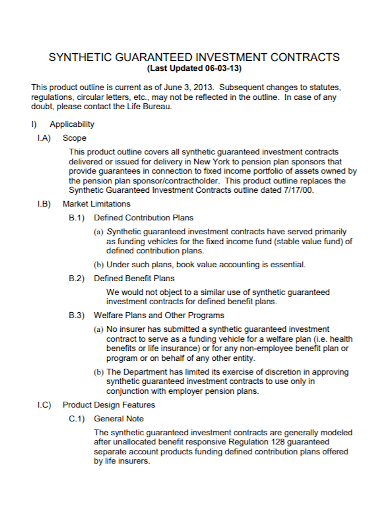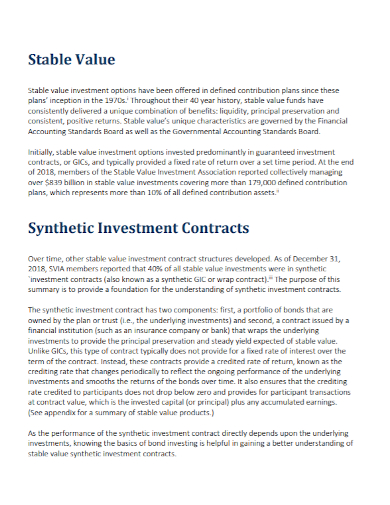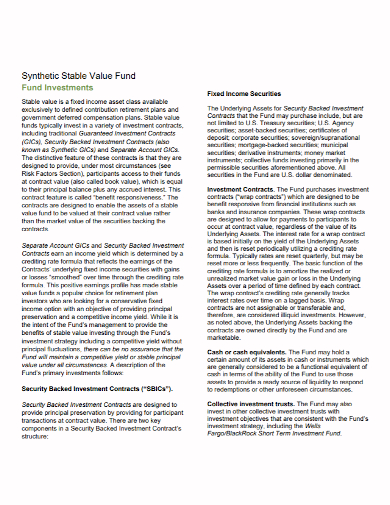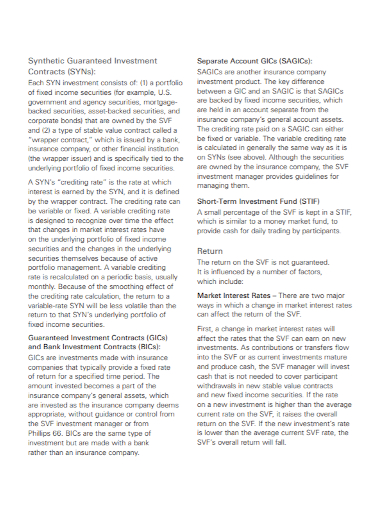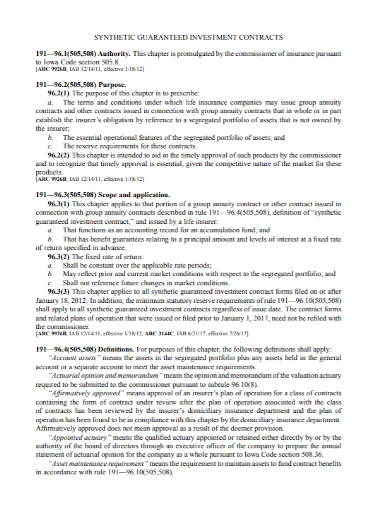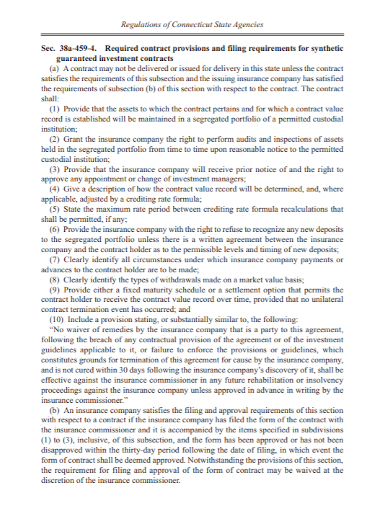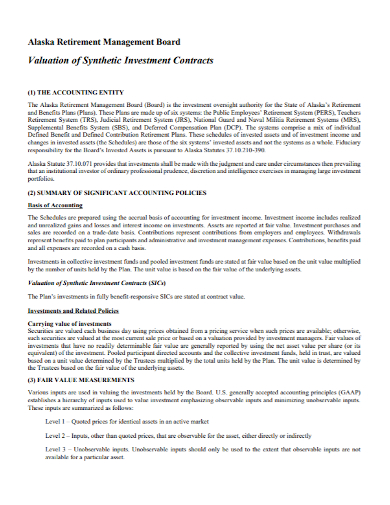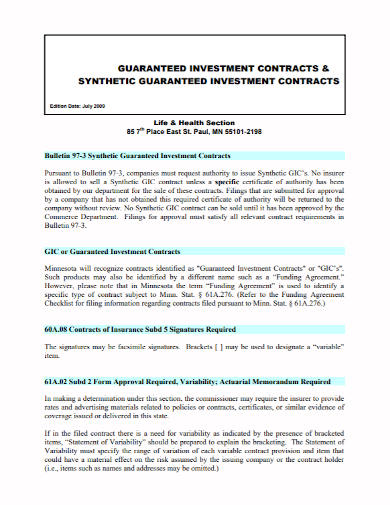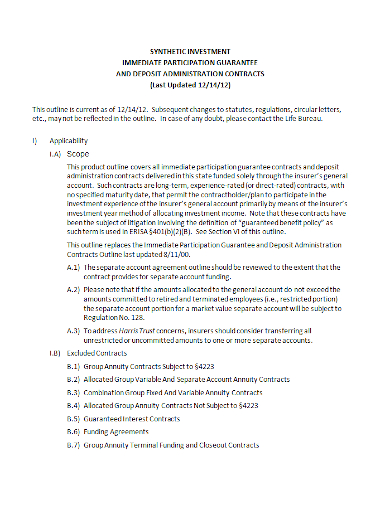Financial instruments that are designed to mimic other instruments while changing key characteristics such as duration and cash flow are referred to as synthetic. Synthetics frequently provide investors with cash flow patterns, maturities, risk profiles, and other features that are tailored to their specific needs. The structure of synthetic products is tailored to the investor’s needs. Synthetic positions are created for a variety of reasons. For example, a trader may choose to create a synthetic short position using options instead of borrowing stock and selling it short because it is easier.
10+ Synthetic Investment Contract Samples
An investment that replicates, or tries to replicate, the cash flows associated with asset ownership (usually security, a basket of securities, index, or other financial instruments). When there is no ownership of the underlying asset, the investment is said to be synthetic. A derivative, most commonly a total return swap (TRS) or an equity swap, is used to accomplish this. Synthetic securitizations are a type of securitization in which the securitized asset pool is primarily made up of derivatives, usually credit default swaps (CDS), and the issuer serves as the credit protection seller. The most common type of synthetic securitization is synthetic collateralized debt obligations (CDOs), though these transactions have become rare since the financial crisis.
1. Synthetic Investment Contract Template

2. Synthetic Guaranteed Investment Contract
3. Synthetic Investment Contract
4. Synthetic Value Investment Contract
5. Synthetic Value Fund Investment Contract
6. Synthetic Account Investment Contract
7. Sample Synthetic Investment Contract
8. Standard Synthetic Investment Contract
9. Synthetic Management Investment Contract
10. Health Synthetic Investment Contract
11. Administration Synthetic Investment Contract
A synthetic investment mimics the performance of real investment, but the return is generated using a combination of financial instruments, such as options contracts, an equity index, and debt securities, rather than a single traditional investment.
For example, an investment firm might create a synthetic index that aims to outperform a specific index by purchasing options contracts rather than the equities that the actual index owns and then investing the money saved in cash equivalents or other debt securities to boost its derivatives return. Synthetic products include options spreads, structured products, certain real estate investments, and guaranteed investment contracts.
While they are artificial, they can serve a legitimate purpose in an individual or institutional investor’s portfolio by reducing risk, increasing diversification, generating a higher return, or meeting needs that traditional investments cannot.
Synthetic investments, on the other hand, may come with additional fees and complexity that you are not comfortable with.
Types of Synthetic Assets
Assets or derivatives can be used to make synthetic products, but synthetic products are derivatives by definition. The cash flows they generate, in other words, are derived from other assets. Synthetic derivatives are an asset class in their own right. These are securities that have been reverse engineered to follow a single security’s cash flows.
Credit default swaps, for example, are invested in synthetic CDOs. The synthetic CDO is further divided into tranches that provide large investors with different risk profiles. These products can provide substantial returns, but the structure can leave high-risk, high-return tranche holders with contractual liabilities that are not fully valued at the time of purchase due to the nature of the structure. Synthetic product innovation has been a boon to global finance, but events like the financial crisis of 2007-09 suggest that synthetic product creators and buyers are not as well-informed as one might hope.
FAQs
What is an example of a synthetic investment?
An option spread, for example, is when a trader takes two or more positions in option contracts in order to profit from the price difference between them. Similarly, a synthetic index can be created to outperform a real index. Synthetic investments are mostly created by institutional investors.
What are convertible bonds?
Companies that want to issue debt at a lower rate should consider convertible bonds. The issuer’s goal is to increase demand for a bond without raising interest rates or the amount of debt it must repay. Investors who want steady income but are willing to give up a few points for the possibility of appreciation are drawn to the ability to switch debt for stock if the stock takes off. To sweeten the deal, different features can be added to the convertible bond. Some convertible bonds come with a guarantee of principal protection. In exchange for a lower conversion factor, other convertible bonds offer higher income. Bondholders are enticed by these features.
If you want to see more samples and formats, check out some synthetic investment contract samples and templates provided in the article for your reference.
Related Posts
Sample Excuse Letter for School
Feature Writing Samples
FREE 10+ Security Guard Contract Samples in PDF | MS Word
FREE 10+ Option to Purchase Agreement Samples in MS Word | Apple Pages | PDF
FREE 26+ Curriculum Form Samples in MS Word | PDF
FREE 20+ Cleaning Service Proposal Samples in PDF | MS Word
FREE 29+ Sample Loan Application Form Templates in MS Word | PDF
FREE 10+ Event Venue Contract Samples in PDF | MS Word | Pages | Google Docs
FREE 10+ SBAR Samples in PDF | DOC
FREE 12+ Music Band Contract Templates in PDF | MS Word
FREE 10+ HVAC Maintenance Contract Samples in PDF | MS Word
FREE 10+ Social Media Marketing Contract Samples in MS Word | PDF
FREE 10+ Wholesale Assignment Contract Samples in PDF
FREE 18+ Financial Proposal Samples in PDF | MS Word | Google Docs | Pages
FREE 10+ Feasibility Study Samples in PDF


